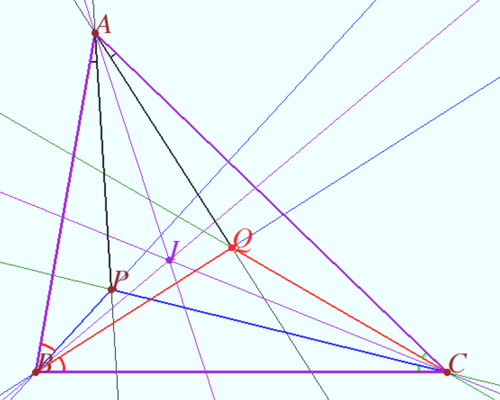Difference between revisions of "Isogonal conjugate"
(→Construction and Theorem) |
|||
| Line 1: | Line 1: | ||
'''Isogonal conjugates''' are pairs of [[point]]s in the [[plane]] with respect to a certain [[triangle]]. | '''Isogonal conjugates''' are pairs of [[point]]s in the [[plane]] with respect to a certain [[triangle]]. | ||
| − | == | + | == Definition of isogonal conjugate of a point == |
| − | + | [[File:Definitin 1.png|500px|right]] | |
Let <math>P</math> be a point in the plane, and let <math>ABC</math> be a triangle. We will denote by <math>a,b,c</math> the lines <math>BC, CA, AB</math>. Let <math>p_a, p_b, p_c</math> denote the lines <math>PA</math>, <math>PB</math>, <math>PC</math>, respectively. Let <math>q_a</math>, <math>q_b</math>, <math>q_c</math> be the reflections of <math>p_a</math>, <math>p_b</math>, <math>p_c</math> over the angle bisectors of angles <math>A</math>, <math>B</math>, <math>C</math>, respectively. Then lines <math>q_a</math>, <math>q_b</math>, <math>q_c</math> [[concurrence | concur]] at a point <math>Q</math>, called the isogonal conjugate of <math>P</math> with respect to triangle <math>ABC</math>. | Let <math>P</math> be a point in the plane, and let <math>ABC</math> be a triangle. We will denote by <math>a,b,c</math> the lines <math>BC, CA, AB</math>. Let <math>p_a, p_b, p_c</math> denote the lines <math>PA</math>, <math>PB</math>, <math>PC</math>, respectively. Let <math>q_a</math>, <math>q_b</math>, <math>q_c</math> be the reflections of <math>p_a</math>, <math>p_b</math>, <math>p_c</math> over the angle bisectors of angles <math>A</math>, <math>B</math>, <math>C</math>, respectively. Then lines <math>q_a</math>, <math>q_b</math>, <math>q_c</math> [[concurrence | concur]] at a point <math>Q</math>, called the isogonal conjugate of <math>P</math> with respect to triangle <math>ABC</math>. | ||
Revision as of 00:57, 6 February 2023
Isogonal conjugates are pairs of points in the plane with respect to a certain triangle.
Definition of isogonal conjugate of a point
Let ![]() be a point in the plane, and let
be a point in the plane, and let ![]() be a triangle. We will denote by
be a triangle. We will denote by ![]() the lines
the lines ![]() . Let
. Let ![]() denote the lines
denote the lines ![]() ,
, ![]() ,
, ![]() , respectively. Let
, respectively. Let ![]() ,
, ![]() ,
, ![]() be the reflections of
be the reflections of ![]() ,
, ![]() ,
, ![]() over the angle bisectors of angles
over the angle bisectors of angles ![]() ,
, ![]() ,
, ![]() , respectively. Then lines
, respectively. Then lines ![]() ,
, ![]() ,
, ![]() concur at a point
concur at a point ![]() , called the isogonal conjugate of
, called the isogonal conjugate of ![]() with respect to triangle
with respect to triangle ![]() .
.
Proof
By our constructions of the lines ![]() ,
, ![]() , and this statement remains true after permuting
, and this statement remains true after permuting ![]() . Therefore by the trigonometric form of Ceva's Theorem
. Therefore by the trigonometric form of Ceva's Theorem
![]() so again by the trigonometric form of Ceva, the lines
so again by the trigonometric form of Ceva, the lines ![]() concur, as was to be proven.
concur, as was to be proven. ![]()
Problems
Olympiad
Given a nonisosceles, nonright triangle ![]() let
let ![]() denote the center of its circumscribed circle, and let
denote the center of its circumscribed circle, and let ![]() and
and ![]() be the midpoints of sides
be the midpoints of sides ![]() and
and ![]() respectively. Point
respectively. Point ![]() is located on the ray
is located on the ray ![]() so that
so that ![]() is similar to
is similar to ![]() . Points
. Points ![]() and
and ![]() on rays
on rays ![]() and
and ![]() respectively, are defined similarly. Prove that lines
respectively, are defined similarly. Prove that lines ![]() and
and ![]() are concurrent, i.e. these three lines intersect at a point. (Source)
are concurrent, i.e. these three lines intersect at a point. (Source)
Let ![]() be a given point inside quadrilateral
be a given point inside quadrilateral ![]() . Points
. Points ![]() and
and ![]() are located within
are located within ![]() such that
such that ![]() ,
, ![]() ,
, ![]() ,
, ![]() . Prove that
. Prove that ![]() if and only if
if and only if ![]() . (Source)
. (Source)










